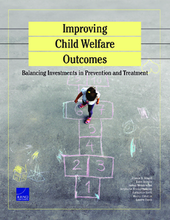To provide objective analyses about the effects of prevention and treatment programs on child welfare outcomes, RAND researchers built a quantitative model that simulated how children enter and flow through the US child welfare system. They then used the model to project how different policy options (preventive services, family preservation treatment efforts, kinship care treatment efforts, and a policy package that combined preventive services and kinship care) would affect a child's pathway through the system, costs, and outcomes in early adulthood. This study is the first attempt to integrate maltreatment risk, detection, pathways through the system, and consequences in a comprehensive quantitative model that can be used to simulate the impact of policy changes.
This research suggests that expanding both prevention and treatment is needed to achieve the desired policy objectives: Combining options that intervene at different points in the system and increasing both prevention and treatment generates stronger effects than would any single option. The simulation model identifies ways to increase both targeted prevention and treatment while achieving multiple objectives: reducing maltreatment and the number of children entering the system, improving a child's experience moving through the system, and improving outcomes in young adulthood. These objectives can all be met while also reducing total child welfare system costs. A policy package combining expanded prevention and kinship supports pays for itself: There is a net cost reduction in the range of 3 to 7 percent of total spending (or approximately $5.2 billion to $10.5 billion saved against the current baseline of $155.9 billion) for a cohort of children born over a five-year period.

